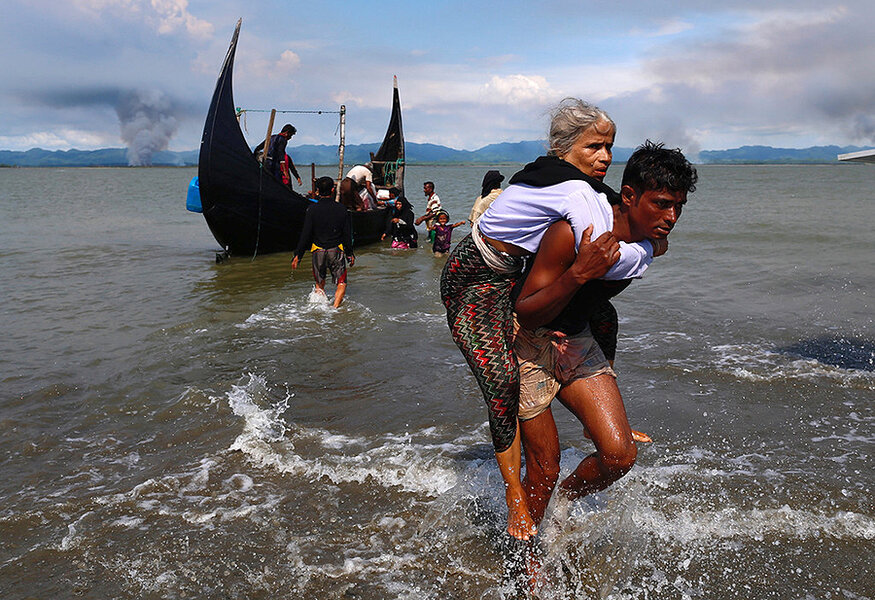Who are the Rohingya? What you should know about Myanmar's deepening crisis
Loading...
Rohingya Muslims in Myanmar (Burma) have endured decades of persecution. But little compares to what they face amid a new wave of violence in the Buddhist-majority country. Some 370,000 Rohingya have fled to Bangladesh.
Who are the Rohingya?
The Rohingya are one of the largest groups of stateless people in the world. An estimated 1 million to 1.2 million live in Myanmar’s western state of Rakhine, where they make up about a third of the population.
Although many Rohingya have lived in Rakhine for generations, the Myanmar government considers them to have come illegally from Bangladesh. Myanmar has used a 1982 citizenship law to deny most Rohingya citizenship, making them stateless. Today, they are deprived of many civil rights and economic opportunities.
The Rohingya have lived under apartheid-like conditions ever since. Government policies and practices restrict their freedom of movement, often putting health care and education out of reach. There are even legal restrictions on their right to marry and the number of children they can have. With little hope of making a life for themselves in Myanmar, many have fled to Bangladesh.
What caused the current crisis?
On Aug. 25, a Rohingya insurgent group, the Arakan Rohingya Salvation Army, attacked police posts and an Army base in northern Rakhine, killing at least 12 members of security forces. The attacks prompted the Myanmar military to retaliate with what it called “clearance operations” to root out “extremist terrorists.” The military said on Sept. 1 that nearly 400 people – mostly insurgents – had been killed.
Reports have since surfaced of the military torching entire Rohingya villages with helicopters and petrol bombs. Satellite images obtained by Human Rights Watch show that well over 1,000 buildings in villages across northern Rakhine have been burned.
The violence has triggered an exodus of Rohingya into already overcrowded refugee camps in Bangladesh. Many brought with them stories of extrajudicial killings, rape, and other atrocities. On Sept. 11, the top human rights official for the United Nations said the Rohingya were facing what “seems a textbook example of ethnic cleansing.”
“The Myanmar government should stop pretending that the Rohingya are setting fire to their own homes and laying waste to their own villages,” Zeid Ra’ad al-Hussein said in Geneva.
How has the Myanmar government responded?
Aung San Suu Kyi, the de facto leader of Myanmar and a Nobel Peace Prize laureate, has been conspicuously silent on the plight of the Rohingya. Critics say her silence has given the military free rein to handle the crisis. Many were shocked to hear her call reports of atrocities committed by security forces fake news that was helping terrorists.
In addition to accusing Rohingya of setting fire to their own villages, the Myanmar government has accused international aid workers of giving assistance to the insurgents. In response to the allegation, Mr. Hussein criticized Ms. Aung San Suu Kyi’s office for issuing “irresponsible” statements that could endanger aid organizations.
This isn’t the first time Aung San Suu Kyi has received international criticism for refusing to acknowledge the magnitude of the military’s crackdown on the Rohingya. In the aftermath of a similar outbreak of violence last October, UN human rights investigators concluded that Myanmar security forces had probably committed crimes against humanity. Aung San Suu Kyi rejected their report. Her government has since barred a new team of UN investigators from entering the country.
What about the international community?
The current crisis has drawn criticism from around the world. On Sept. 13, the UN Security Council called for “immediate steps to end the violence in Rakhine.” It was the first statement in nine years that the Council had made on the situation in Myanmar, according to Matthew Rycroft, Britain’s UN ambassador.
On Sept. 8, the Dalai Lama became the latest Nobel Peace Prize laureate to speak out, following statements from Desmond Tutu of South Africa and Malala Yousafzai of Pakistan. The Tibetan spiritual leader said people who are harassing Muslims “should remember Buddha.”
“I think such circumstances Buddha would definitely help to those poor Muslims,” he told journalists in Dharamsala, India.
The United States, a close supporter of Myanmar’s transition from decades of military rule, has spoken out against the violence. British lawmakers are pushing to suspend assistance to the Myanmar military.
What are international aid organizations doing?
In Bangladesh, they’re scrambling to provide food, medicine, and shelter to the Rohingya refugees. Many are arriving hungry and exhausted after walking through jungle and mountains for several days, according to the UN refugee agency. “It is a real humanitarian disaster there,” says Phil Robertson, deputy director of Human Rights Watch’s Asia division. “Everything is overwhelmed.”









